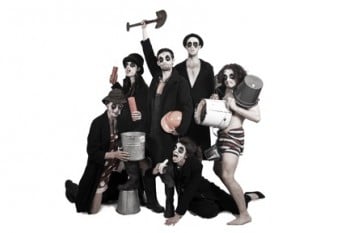Meta zombies!
There’s a special delight in being pleasantly surprised. Being unfamiliar with the work of the DIG collective, I didn’t really know what their fringe show DIG would entail. Now that I’ve seen it, I’m still not all that sure, but I enjoyed the unearthing.

The audience files in as a white-faced man with a vacant expression (Michael Fee) stands in the background holding a doctor’s leather bag. Blackened eyes take long blinks as sounds of digging come through the speakers, his sustained torpor creating tension. A similarly made-up crew, led by a foul-mouthed angry foreman (David Harris) burst forth and proceed with their noisy and seemingly pointless work of moving buckets across the stage to the sound of Johnny Cash’s “Folsom Prison Blues”, making a speedy exit when the job is done. The scene repeats as one’s distracted by a fetish for buckets (a rapturous Joshua Lynzaat), another by a desire for bananas (played with a glirine intensity by Dana McMillan), which agitates the boss more than usual. As the iterations continue, the zombie observer seems to tire, his grasp on the bag slackening …
The following keeps shifting the ground beneath the audience with multiple threads, somehow linked to that bag. Characters interact in highly physical ways that range from comic chase scenes to a tense battle of wills. They effuse individuality: Tim Sneddon has facial expressions worthy of an Aardman animated film and Grace Cummings is a chimera of black cat and Russian Spy as she stalks the stage.
The world shifts into a meta-theatrical orbit as Harris expresses thoughts on the show, earning the laugher of recognition from the audience. In-jokes about actor processes and stereotypes continue to undermine the earlier drama. Director Alex Talamo deserves credit for ensuring motifs are established while still keeping the action crisply moving.
At this point, if you are even slightly interested, stop reading and go. Although the fringe is nearly finished, I’m sure there’ll be another chance to see the collective. You can always come back to read the rest of my thoughts, without polluting your experience with my theories of subterrainian meanings.
The piece doesn’t give away much early as it just seems odd, for example, the “workers” are routinely required to pose as they go about their duties. The appearance of a character composed only of a suit jacket and hat is the turning point in this piece. Skillfully animated by Fee, it subdues the cast one by one, converting them to similar dress as they continue their work. The ending, where the quirks of characters are amplified to extreme levels as they remain trapped in their cycle of bucket transportation, made me wonder if the collective are having a “dig” at the conservatism of sectors of the entertainment industry – maybe Australian tv? – where artists adopt a business-type uniform and it’s easier to give the public something they’re already familiar with than put effort into developing new product.
No one could accuse DIG of ripping off what’s gone before. This highly entertaining show works through discipline and precision. In their manifesto, the DIG collective reserve the right to do the stupidest things. They may be stupid at times, but their show is certainly not dumb.
